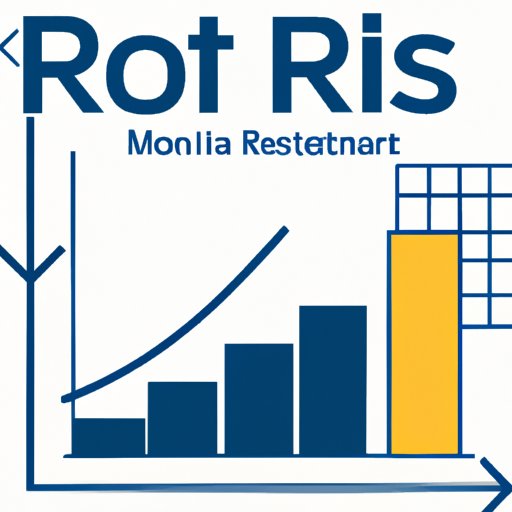Introduction
Return on investment (ROI) is one of the most important concepts in investing and finance. It is a measure of the profitability of an investment and can be used to compare different investments. Calculating your ROI is essential for making informed decisions about where to invest your money. In this article, we’ll explore what return on investment is, how to calculate it, and strategies for maximizing your ROI.

A Guide to Understanding Return on Investment
What is Return on Investment?
Return on investment (ROI) is a measure of the profitability of an investment. It is calculated by dividing the net profit from an investment by the initial cost of the investment. For example, if you invested $1,000 and earned a return of $1,200, your ROI would be 20%.
What Factors Affect ROI?
There are several factors that can affect the return on an investment. These include the amount of money invested, the type of investment, the length of time the investment is held, and the risk involved. Higher-risk investments typically have higher potential returns, but they also come with more risk. Lower-risk investments tend to have lower returns, but they also come with less risk.
How to Calculate Your ROI
Calculating your return on investment is relatively simple. All you need to know is the total amount invested, the net profit or loss, and the length of time the investment was held. You can then calculate your ROI using the following formula:
ROI = (Net Profit/Investment Cost) x 100

Calculating Your Return on Investment
Step-by-Step Guide to Calculating Your ROI
To calculate your return on investment, follow these steps:
- Determine the total investment cost. This should include any fees associated with the investment, such as broker commissions.
- Calculate the net profit or loss. This is the difference between the total proceeds from the sale of the investment and the total investment cost.
- Divide the net profit or loss by the total investment cost.
- Multiply the result by 100 to get your ROI as a percentage.
Examples of How to Calculate Your ROI
Here are two examples of how to calculate ROI:
- Example 1: You invest $10,000 in a stock and earn a return of $12,000. Your ROI would be 20%:
(12,000 – 10,000) / 10,000 x 100 = 20%. - Example 2: You invest $5,000 in a bond and earn a return of $4,000. Your ROI would be -20%:
(4,000 – 5,000) / 5,000 x 100 = -20%.

The Benefits of a High Return on Investment
Increased Profitability
One of the main benefits of a high return on investment is increased profitability. According to a study by the Harvard Business Review, “Companies with higher ROI are more profitable and grow faster than those with lower ROI.” This means that investors who are able to achieve a high ROI will be rewarded with increased profits.
Reduced Risk
High ROI investments also come with reduced risk. This is because the higher the return on investment, the more likely it is that the investment will be successful. As the old adage goes, “high risk, high reward.” Investing in high ROI investments can help reduce the risk associated with investing.
Increased Financial Flexibility
Finally, high return on investment investments offer increased financial flexibility. This means that investors can use their profits to make additional investments or to pay off debt. This can help investors reach their financial goals sooner and increase their overall financial security.
How to Maximize Your Return on Investment
Research and Invest in Quality Assets
When investing, it’s important to research and invest in quality assets. This means understanding the risks associated with each investment and choosing investments that have a strong track record of delivering good returns. By researching and investing in quality assets, you can maximize your ROI.
Understand the Market and Choose Wisely
It’s also important to understand the market and choose investments wisely. This means taking the time to do the research and understanding the different types of investments available. By understanding the market and choosing investments wisely, you can ensure that you are maximizing your ROI.
Monitor Your Investments Regularly
Finally, it’s important to monitor your investments regularly. This means keeping an eye on the performance of your investments and making adjustments as needed. By monitoring your investments regularly, you can ensure that you are getting the best possible return on your investments.
Common Mistakes to Avoid When Calculating ROI
Not Properly Accounting for All Costs
One of the most common mistakes when calculating ROI is not properly accounting for all costs associated with the investment. This includes fees, taxes, and other costs that may not be immediately apparent. Failing to account for all costs can significantly reduce your ROI.
Failing to Account for Inflation
Another mistake to avoid when calculating ROI is failing to account for inflation. Inflation can have a significant impact on the value of an investment over time. By taking inflation into account when calculating ROI, you can get a better understanding of the true return of an investment.
Not Utilizing Tax Strategies
Finally, it’s important to utilize tax strategies when calculating ROI. Taking advantage of tax deductions, credits, and other tax strategies can help increase your ROI. By utilizing tax strategies, you can ensure that you are maximizing your return on investment.
What Every Investor Should Know About Return on Investment
The Impact of Time on ROI
Time can have a significant impact on ROI. The longer an investment is held, the more time it has to appreciate in value. This is known as the power of compounding interest, which can significantly increase the return of an investment over time.
The Power of Compounding Interest
Compounding interest is the process of earning interest on interest. This means that the money you earn from an investment is reinvested and earns more interest over time. This can significantly increase the return of an investment, especially over long periods of time.
The Benefits of Diversifying Your Portfolio
Diversifying your portfolio is another way to maximize your ROI. By diversifying your investments, you can reduce your overall risk while still achieving a high return. This is because different investments will perform differently in different market conditions, so diversifying your portfolio can help protect against large losses.
Conclusion
Return on investment is an important concept for investors to understand. It is a measure of the profitability of an investment and can be used to compare different investments. By understanding how to calculate ROI, the benefits of a high ROI, and strategies for maximizing returns, investors can make informed decisions about where to invest their money.
(Note: Is this article not meeting your expectations? Do you have knowledge or insights to share? Unlock new opportunities and expand your reach by joining our authors team. Click Registration to join us and share your expertise with our readers.)
